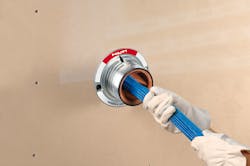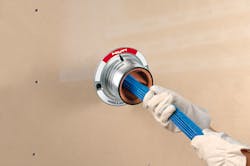Firestopping systems are as important as ever
By Patrick McLaughlin
David Cranmer, founder of Ventoux Learning Network (ventouxlearningnetwork.com), recently began posting a weekly video introducing a topic covered in one of Ventoux’s courses. Each of Ventoux’s a-la-carte courses is based on a chapter of BICSI’s Telecommunications Distribution Methods Manual (TDMM). The courses are designed to prepare candidates to take BICSI’s Registered Communications Distribution Designer (RCDD) exam. The RCDD exam is based on the contents of the TDMM.
The video Cranmer posted on February 29 covers the TDMM’s Chapter 7, which covers firestop systems. To open, Cranmer explains, “There are four components to fire protection: prevention, detection, suppression, and compartmentation. As an RCDD, it’s your responsibility to address the issue of compartmentation.” He further explains that compartmentation “is a form of passive fire protection, and protects by its inherent properties. Firestop applications are through-penetration, membrane-penetration, joint, and perimeter. The most important of these for the RCDD are through-penetration and membrane-penetration.”
A through-penetration, Cranmer further explained, occurs when a cable, conduit, or sleeve system passes through an opening in a fire-rated floor or wall. A membrane-penetration, he added, occurs when the service element passes through only a single side of the wall or floor.
“Building construction plays a major role in compartmentation,” he said. “Building codes require fire-rated floors and walls to do a number of things-the first is to isolate the areas in which hazards are likely to exist; second is to subdivide the areas to enhance the protection of lives and property.”
Managing change
Building systems of several types make their way through fire-rated walls and floors, thereby requiring compartmentation in the form of firestopping. Brian Hengstenberger, national accounts manager with Specified Technologies Inc. (STI; stifirestop.com), points out, “Data communications cabling is definitely the area where frequent moves, additions, and changes are most frequently required. Most other building services are installed and firestopped permanently. While improved methods of protecting other building systems have been introduced, cable pathway firestop systems have definitely been an area of intense focus and development to provide increased flexibility for both the contractors installing the cables, as well as the building occupants or owners who may upgrade the cabling infrastructure throughout the life of the building.”
One method of firestopping existing cable pathways is to use a split-sleeve system. On its website, Unique Firestop Products (uniquefirestop.com) explains this method both meets a critical needs and has specific advantages. “Building codes are a requirement for the simple reasons of safety and insurance against improper building techniques on all commercial buildings,” Unique says. “One of the most serious code violations occurs when a firewall is penetrated and not sealed properly. In an inspection that reveals cable penetrations that violate a rated firewall, the inspector may require the cables be removed, the wall sleeved with a conduit and re-installation of the cables.”
Unique Fire Stop Products adds that retrofitting low-voltage violations “have left a lot to be desired with ‘approved’ or ‘tested’ systems. Most systems deal only with point of entry and exit. Simply filling in around installed cables with caulk or putty will not satisfy most inspectors. If the cables in question are running equipment that can’t be shut down-like computer systems in hospitals or factories, security cameras or other important systems-you have a problem.
“In today’s commercial building environment you will need to prepare to meet and make happy the fire marshal, the local building inspector, as well as the county inspectors. Through penetrations should be functional, easily installed, re-enterable, and reasonably priced.” A split-sleeve firestop system meets this need, Unique contends.
Unique Fire Stop Products’ Split Sleeve system was developed to meet a need that is specific to communications cabling systems, and that emerged as a result of the fact that these systems are dynamic, rather than static, even after installation.
Evolving over time
We asked STI’s Hengstenberger to explain how the company’s firestop products and systems have evolved over the years to meet the evolving requirements of cable pathways. He explained that since the company’s inception more than 25 years ago, “We have sold non-hardening firestop putty. It is used primarily in applications where re-enter-ability or retrofit is a consideration. Historically, firestop putty was the preferred product for cabling systems subject to frequent moves, additions, or changes.
“As versatile as putty is, there are some limitations. Putties are desirable because they can be easily removed. Unfortunately, there are also situations in which the installer may inadvertently forget to replace the putty. Putty systems require a minimum volume or dose to properly firestop a cable system. In general, it is approximately 1 inch of clearance between a cable bundle and the periphery of the opening. As more cable is added, the putty is displaced and that can comprise the integrity of the firestop system.”
STI’s EZ-Path Fire Rated pathway was introduced in 2002, and Hengstenberger recalled, “The idea behind the product was to provide re-enter-ability, while eliminating the chance that the firestop material would not be properly replaced. Thus, the concept of zero-maintenance cable sealing was born.
“The other advantage to the EZ-Path system is that it could never be overwhelmed. If a cable fits, it is properly firestopped. While building and safety codes are quite clear with regard to the need to firestop cable penetrations, one often-overlooked requirement is the maintenance of fire-rated features such as firestopping systems. Fire codes require fire protection features such as firestop systems to be inspected and maintained. Any system that requires an action to provide the sealing function requires inspection and maintenance to ensure it is properly sealed.”
Smaller pathways
Another recent trend in structured cabling that has firestop implications is the running of small bundles, or even single cables, within buildings. “Implementation of low-voltage drops for things such as wireless access points, access control card systems, or security cameras are constantly being deployed after cabling plants are in place,” STI’s Hengstenberger said. When these single-cable or small-cable-bundle applications penetrate fire-rated walls or floors, they must be firestopped. Firestopping providers have developed smaller-scale products to accommodate these runs of fewer cables. STI’s EZ-Firestop Grommets are examples.
Another example are Unique Fire Stop Products’ Future Proof Plates (FPPs), which allow users to “centralize, install and maintain firewall penetrations made by telecom installers for the life of a new building,” the company says. “FPPs allow cable bundles to be in designated positions by design, allowing for ease of maintenance by centralizing all potential penetrations,” the company adds. “FPPs can be designed with multiple holes for all the different types of cabling to be installed, smoke-sealed and firestopped.” The holes can vary in size, thereby accommodating large or small bundles.
“Designers can plan enough holes in FPPs for future cabling and avoid the lack-of-planning pitfalls for the life of the building, if properly maintained. FPPs can be used with any type of mechanical sleeve system on the market today,” Unique concludes.
In addition to providing systems that restore floors and walls to their original fire rating, firestop-system vendors provide systems for smoke and acoustical solutions for non-fire-rated penetrations. One example is Hilti’s (ca.hilti.com) Smoke and Acoustic Sleeve CS-SL SA. When Hilti introduced the product in November 2015, it said, “This new sleeve allows Hilti to offer customers an option that is fast and easy to install as well as being technically superior for non-fire-rated cable penetrations requiring a sleeved opening.”
Hilti added that the CS-SL SA “features superior ‘in-use’ sound and air-leakage rating to help mitigate smoke and sound.” The sleeve is available in a 2-inch-diamter size as well as a 4-inch-diameter size and is compatible with the company’s gangplate solution.
Patrick McLaughlin is our chief editor.

